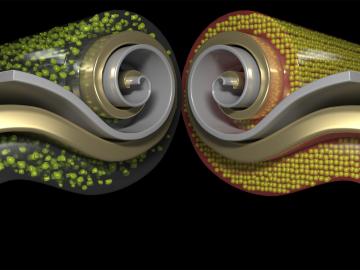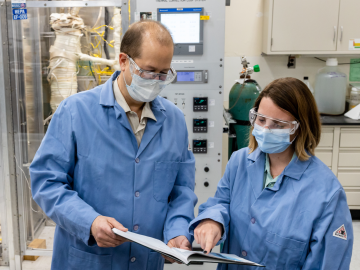
Filter News
Area of Research
- (-) Fusion and Fission (27)
- (-) Neutron Science (127)
- Advanced Manufacturing (4)
- Biological Systems (1)
- Biology and Environment (119)
- Biology and Soft Matter (1)
- Computational Biology (2)
- Computational Engineering (3)
- Computer Science (8)
- Electricity and Smart Grid (1)
- Energy Frontier Research Centers (1)
- Energy Science (140)
- Energy Sciences (1)
- Functional Materials for Energy (2)
- Fusion Energy (15)
- Isotopes (8)
- Materials (120)
- Materials for Computing (15)
- Mathematics (1)
- National Security (25)
- Nuclear Science and Technology (15)
- Quantum information Science (1)
- Supercomputing (89)
News Topics
- (-) Biomedical (15)
- (-) Clean Water (2)
- (-) Energy Storage (10)
- (-) Environment (10)
- (-) Exascale Computing (1)
- (-) Fusion (22)
- (-) Machine Learning (3)
- (-) Nanotechnology (11)
- (-) Neutron Science (120)
- 3-D Printing/Advanced Manufacturing (9)
- Advanced Reactors (7)
- Artificial Intelligence (7)
- Big Data (2)
- Bioenergy (8)
- Biology (7)
- Biotechnology (1)
- Buildings (1)
- Chemical Sciences (7)
- Composites (2)
- Computer Science (14)
- Coronavirus (10)
- Critical Materials (1)
- Cybersecurity (1)
- Education (1)
- Fossil Energy (2)
- Frontier (2)
- Grid (2)
- High-Performance Computing (4)
- Hydropower (1)
- Isotopes (1)
- ITER (6)
- Materials (14)
- Materials Science (24)
- Mathematics (1)
- Microscopy (4)
- National Security (2)
- Nuclear Energy (29)
- Partnerships (3)
- Physics (10)
- Polymers (1)
- Quantum Computing (1)
- Quantum Science (7)
- Security (3)
- Simulation (3)
- Space Exploration (3)
- Summit (6)
- Transportation (7)
Media Contacts

Researchers at ORNL have developed a new method for producing a key component of lithium-ion batteries. The result is a more affordable battery from a faster, less wasteful process that uses less toxic material.

Neutron scattering techniques were used as part of a study of a novel nanoreactor material that grows crystalline hydrogen clathrates, or HCs, capable of storing hydrogen.

Oak Ridge National Laboratory scientists recently demonstrated a low-temperature, safe route to purifying molten chloride salts that minimizes their ability to corrode metals. This method could make the salts useful for storing energy generated from the sun’s heat.

Researchers at ORNL and the University of Tennessee, Knoxville, discovered a key material needed for fast-charging lithium-ion batteries. The commercially relevant approach opens a potential pathway to improve charging speeds for electric vehicles.

Researchers in the geothermal energy industry are joining forces with fusion experts at ORNL to repurpose gyrotron technology, a tool used in fusion. Gyrotrons produce high-powered microwaves to heat up fusion plasmas.

Scientists at ORNL used neutron scattering to determine whether a specific material’s atomic structure could host a novel state of matter called a spiral spin liquid.

To solve a long-standing puzzle about how long a neutron can “live” outside an atomic nucleus, physicists entertained a wild but testable theory positing the existence of a right-handed version of our left-handed universe.

Practical fusion energy is not just a dream at ORNL. Experts in fusion and material science are working together to develop solutions that will make a fusion pilot plant — and ultimately carbon-free, abundant fusion electricity — possible.

To achieve practical energy from fusion, extreme heat from the fusion system “blanket” component must be extracted safely and efficiently. ORNL fusion experts are exploring how tiny 3D-printed obstacles placed inside the narrow pipes of a custom-made cooling system could be a solution for removing heat from the blanket.

ORNL researchers used the nation’s fastest supercomputer to map the molecular vibrations of an important but little-studied uranium compound produced during the nuclear fuel cycle for results that could lead to a cleaner, safer world.


